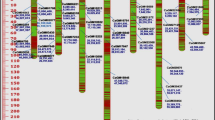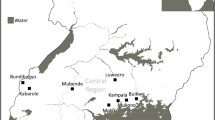Abstract
The native Theobroma cacao L. population from Ecuador, known as Nacional, is famous for its fine cocoa flavour. From the beginning of the twentieth century, however, it has been subjected to genetic erosion due principally to successive introductions of foreign germplasm whose hybrid descendants gradually replaced the native plantations, implying a decrease in cocoa quality. We attempted to trace this native cacao within a wide pool of modern Ecuadorian cacao population. Three hundred and twenty-two cacao accessions collected from different geographical areas along the pacific coast of Ecuador and maintained in two living collections were analysed using 40 simple-sequence repeat markers. Most of Ecuadorian cacao accessions displayed a high diversity and heterozygosity level. A factorial analysis of correspondence (FAC) showed a continuous variation among them, with a few ones, grouped at an extreme side of the FAC cloud, showing higher levels of homozygosity and lower introgression level by foreign cacaos. A paternity analysis revealed that these highly homozygous individuals are the most probable ancestors of the modern Nacional hybrid pool. These particular accessions studied could represent the native Nacional cacao present in Ecuador before the foreign introductions. Their identification will help to conserve valuable genetic material and to improve cocoa quality in new cacao varieties.




Similar content being viewed by others
References
Allen BJ, Lass AR (1983) London cocoa trade Amazon project. Final report phase 1. Cocoa Grow Bull 34:1–72
Ampuero E (1960) Progresos alcanzados en el Ecuador en el estudio de selección para resistencia de la Escoba de Bruja. Proceeding of the Inter American Cacao Conference. Bowen, Trinidad, pp 166–173
Belkhir K, Borsa P, Chikhi L, Raufaste N, Bonhomme F (2004) GENETIX 4.05, logiciel sous Windows TM pour la génétique des populations, Laboratoire Génome, Populations, Interactions; CNRS UMR 5000. Université Montpellier II, France
Benzecri JP (1973) L’analyse des données. Tome 2: L’analyse des correspondances. Dunod, Paris, France
Cheesman EE (1944) Notes on the nomenclature, classification and possible relationships of cacao populations. Trop Agric 21:144–159
Deheuvels O, Decazy B, Perez R, Roche G, Amores F (2004) The first Ecuadorean Nacional cocoa collection based on organoleptic characteristics. Trop Sci 44:23–27
Dervin C (1992) Analyses des Correspondances. Comment interpréter les résultats? Collection STAT-ITCF. Paris, France
Enriquez GA (1992) Characteristics of cacao “Nacional” of Ecuador. International Workshop on Conservation, Characterisation and Utilisation of Cocoa Genetic Resources in the 21st century. Port of Spain, Trinidad 13–17th September. The Cocoa Research Unit, The University of the West Indies, pp 269–278
Fowler RL, Lopez GH (1949) The cacao industry of Ecuador. Foreign Agriculture Report No. 34, US Department of Agriculture, Washington, USA
Hartl DL, Clark AG (1997) Principles of population genetics, 3rd edn. Sinauer, Sunderland, Massachusetts, USA
Hurst WJ, Tarka SM, Powis TG, Valdez F, Hester RT (2002) Archaeology: cacao usage by the earliest Maya civilization. Nature 418:289–290
Lanaud C, Risterucci AM, Pieretti I, Falque M, Bouet A, Lagoda PJL (1999) Isolation and characterisation of microsatellites in Theobroma cacao L. Mol Ecol 8:2141–2152
Lanaud C, Risterucci AM, Pieretti I, N’Goran JAK, Fargeas D (2004) Characterization and genetic mapping of resistance and defence gene analogs in cocoa (Theobroma cacao L.). Molecular Breeding 13:211–227
Laurent V, Risterucci AM, Lanaud C (1994) Genetic diversity in cocoa revealed by cDNA probes. Theor Appl Genet 88:193–198
Lerceteau E, Robert T, Pétiard V, Crouzillat D (1997a) Evaluation of the extent of genetic variability among Theobroma cacao L accessions using RAPD and RFLP markers. Theor Appl Genet 95:10–19
Lerceteau E, Flipo S, Pétiard V, Crouzillat D (1997b) Genetic differentiation among Ecuadorian Theobroma cacao L. accessions using molecular and morphological analyses. Euphytica 95:77–87
Liu K, Muse VS (2005) Power marker: integrated analysis environment for genetic marker data. Bioinformatics 21:2128–2129
Loor RG (1998) Obtención de híbridos de cacao tipo Nacional provenientes de materiales de alta productividad y resistentes a enfermedades. Tesis de Ingeniero Agrónomo. Universidad Técnica de Manabí, Portoviejo, Ecuador
Loor RG, Saunders JA, Amores F (2002) Characterization of Ecuadorian cacao (Theobroma cacao L.) Mid Atlantic Plant Molecular Biology Society Proceedings. Beltsville, Maryland, USA 19:18
Marshall TC, Slate J, Kruuk LEB, Pemberton JM (1998) Statistical confidence for likelihood-based paternity inference in natural populations. Mol Ecol 7:639–655
Motamayor JC, Risterucci AM, Lopez PA, Ortiz CF, Moreno A, Lanaud C (2002) Cacao domestication I: the origin of the cacao cultivated by the Mayas. Heredity 89:380–386
Motamayor JC, Risterucci AM, Heath M, Lanaud C (2003) Cacao domestication II: progenitor germplasm of Trinitario cacao cultivar. Heredity 91:322–330
Nei M (1972) Genetic distance between populations. Am Nat 106:283–292
Nei M (1978) Estimation of average heterozygosity and genetic distance from a small number of individuals. Genetics 89:583–590
N’Goran JAK, Laurent V, Risterucci AM, Lanaud C (1994) Comparative genetic diversity of Theobroma cacao L. using RFLP and RAPD markers. Heredity 73:589–597
N’Goran JAK, Laurent V, Risterucci AM, Lanaud C (2000) The genetic structure of cocoa populations (Theobroma cacao L.) revealed by RFLP analysis. Euphytica 115:83–90
Pastorelly RD (1992) Evaluación de algunas características del cacao tipo Nacional, en la zona de Tenguel. Tesis Ingeniero Agrónomo. Universidad Agraria del Ecuador. Guayaquil, Ecuador
Perrier X, Flori A, Bonnot F (2003) Data analysis methods. In: Hamon P, Seguin M, Perrier X, Glaszmann JC (eds) Genetic diversity of cultivated tropical plants. Enfield, Science Publishers, Montpellier, France, pp 43–76
Phillips D (1995) Correspondence analysis. Social research update. Department of Sociology, University of Surrey, Guildford GU2 7XH, England
Pound FJ (1938) Cacao and witches’ broom disease (Marasmius perniciosus) of South America, with notes on other species of Theobroma. Yuille’s Printerie, Port of Spain, Trinidad and Tobago, 9–49. Reprinted 1982. Arch Cocoa Res 1:21–64
Pound FJ (1945) A note about the cacao populations of South America. Report and Proceedings Cocoa Research Conference, London. Colonial 192:95–7. Reprinted 1982. Arch Cocoa Res 1:93–97
Pugh T, Fouet O, Risterucci AM, Brottier P, Abouladze M, Deletrez C, Courtois B, Clement D, Larmande P, N’Goran JAK, Lanaud C (2004) A new cacao linkage map based on codominant markers: development and integration of 201 new microsatellite markers. Theor Appl Genet 108:1151–1161
Quiroz J (1990) Estudio de la compatibilidad en algunos cultivares de cacao (Theobroma cacao L.). Tesis de Ing. Agr. Universidad Técnica de Babahoyo, Ecuador
Quiroz J (2002) Caracterización molecular y morfológica de genotipo superiores de cacao nacional (Theobroma cacao L.) de Ecuador. Tesis Ms.Sc. Centro Agronómico Tropical de Investigación y Enseñanza. Turrialba, Costa Rica
Risterucci AM, Grivet L, N’Goran JAK, Pieretti I, Flament MH, Lanaud C (2000) A high-density linkage map of Theobroma cacao L. Theor Appl Genet 101:948–955
Rorer JB (1926) Ecuador cacao. Trop Agric (Trinidad) 3:69–69
Soria JV (1970) Principal varieties of cocoa cultivated in tropical America. Cocoa Grow Bull 19:12–21
Van Hall CJ (1932) Cocoa, 2nd edn. MacMillan, London, pp 304–320
Vera BJ (1987) Antecedentes históricos. Manual del cultivo de cacao. INIAP, EET-Pichilingue, Quevedo, Ecuador, pp 6–9
Vera BJ (1993) Botánica del cacao. Manual del cultivo de cacao 2da edición. INIAP, EET-Pichilingue, Quevedo, Ecuador, pp 10–15
Weir BS, Cockerhan CC (1984) Estimating F-statistics for the analysis of population structure. Evolution 38:1358–1370
Acknowledgements
We are grateful to the United States Department of State (US Foreign Ministry), the US Embassy, Quito; and the US Department of Agriculture (USDA-ARS) for the financial support of this research. Thanks also should go to the Centre de Coopération International en recherche agronomique pour le développement (CIRAD), France and the Agricultural Research Center of Ecuador (INIAP) for their financial and technical support. We thank Dr Surendra SURUJDEO-MAHARAJ for improving the English writing of this manuscript.
Author information
Authors and Affiliations
Corresponding author
Additional information
Communicated by A. Abbott
Rights and permissions
About this article
Cite this article
Loor, R.G., Risterucci, A.M., Courtois, B. et al. Tracing the native ancestors of the modern Theobroma cacao L. population in Ecuador. Tree Genetics & Genomes 5, 421–433 (2009). https://doi.org/10.1007/s11295-008-0196-3
Received:
Revised:
Accepted:
Published:
Issue Date:
DOI: https://doi.org/10.1007/s11295-008-0196-3




